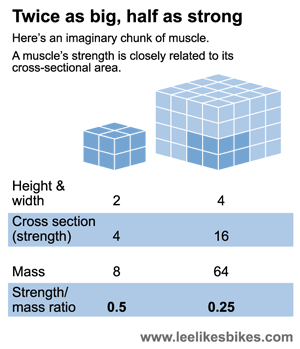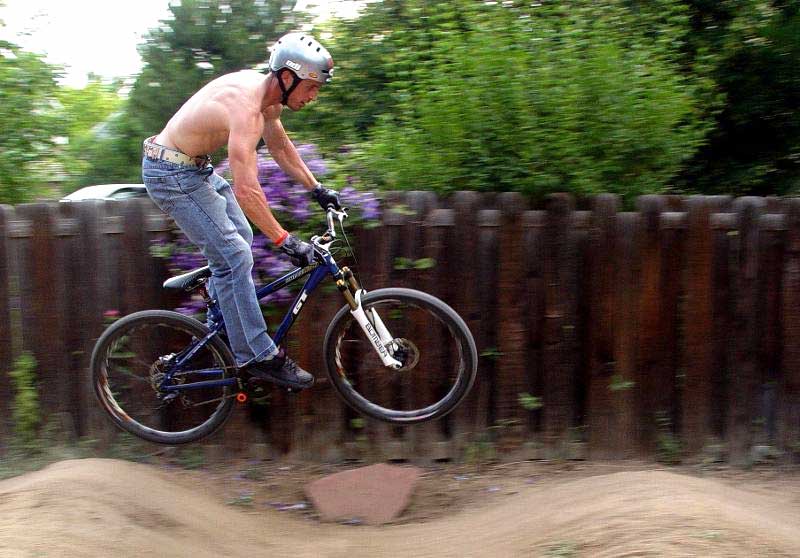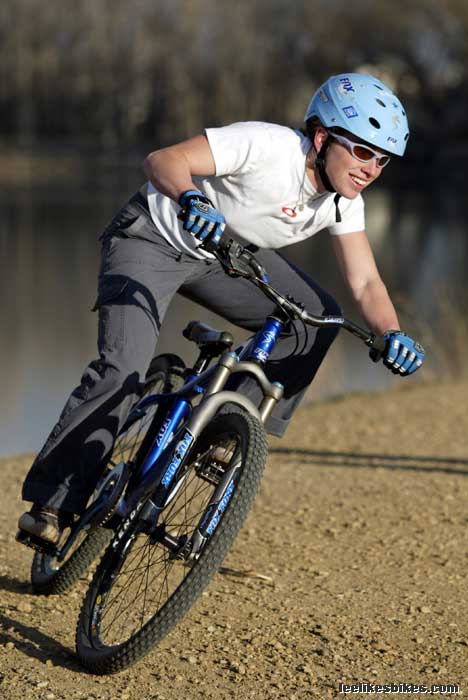Can big riders jump?

Hey Lee,
First, I’d like to thank you for putting together a great book and website. I consider myself an intermediate dh rider, riding a couple of times a week and entering a few races a year. I know you get a lot of questions on jumping but I would like to know what effect rider weight has on jumping?
 I’ll bet Brian Lopes can deadlift close to three times his weight. That translates into impressive pop off jumps. |
From what I can tell, at least from a physics standpoint is that speed and ramp angle are the only factors that affect distance and height given the same technique and other variables. So I’m inclined to think my jumping ability is hindered more by ability to carry speed than by my mass. Then again I don’t see many 255 lb people spend that much time in the air in any sport. This isn’t really an overweight issue as my weight is more a factor of muscle density than flab. I guess what I’m getting at is that I want to become a better all around rider and as a better jumper I would be better at riding the jump laden courses out there. I’m just not quite sure how to go about that. Thanks!
John
Hi John.
Man, what a fun question. Fun for a nerd like me, anyway.
You’re right that being heavy doesn’t change the core dynamics of jumping. When you negate air resistance, cannon balls, bowling balls and BBs all fly the same. For that matter, so do feathers.
Catching air (literally)
When you jump your bike, air resistance is a relatively small factor, but a bigger rider is less affected than a small rider (because the ratio of weight to drag is higher). So, all things being equal on a windy day, a 255-lb stud will fly farther than a 140-lb spud.
 Pound for pound, Bobbi Watt is hard to beat. |
It’s all about the pump
The big variable here — and one you control — is the amount you compress into the face of the jump. The harder you load into the face of the jump, the more you rebound, and the higher you go. It’s exactly like diving off a diving board — the farther you compress the board, the higher it sends you.
Timid and/or weak riders don’t pump very hard, so they seldom jump well. Confident, strong riders pump VERY hard, and that’s the key to their jumping kung fu. A rider like Brian Lopes or Steve Wentz can bunny hop three feet on flat ground and get huge air of a tiny lip. I’ve seen Wentz gap 15 feet off a shovel.
Bigger is weaker
When we talk about pumping a lip, we’re not talking about the absolute downforce. We’re talking about the downforce compared with your body weight. When Bobbi Watt (~120lbs) and you (255lbs) each pump with 120 pounds of force, she gets more than twice the lift.
Equal pump x 1/2 the weight = 2X the pop
 A little infographic magic for the kids at home. |
Pound for pound, larger animals tend to be weaker than smaller animals. Why? As you get larger, your volume (and weight) increase faster than the cross-sectional area of your muscles. Basically:
2X as large -> 4X muscle cross section -> 8X weight
When you double your size, you can lift four times as much as before, but you weigh eight times more. So your strength/weight ratio is cut in half.
Here’s a cool explanation of size/weight/strength relationships.
We periodically do Feats of Strength in my basement. You weigh yourself on the spot, then you lift a percentage of your weight to failure. We bench half our weight, pull down half our weight, row with half our weight, military press one-quarter our weight and do dips. So far, Bobbi Watt is the champion. Lopes and I each managed 31 dips — she cranked out 32 then stopped just to make the point.
Bike riding is all about strength-to-weight ratio, and — overall — smaller riders have a distinct advantage there.
Let’s wrap this up
A big guy like you can definitely become a great jumper if you work on your timing and commitment. Just remember that for the same amount of lift, you’ll have to pump harder than the little guys. You’ll never achieve the pop of Lopes and Wentz, but I’d rather move a piano with you!

Comments are closed.